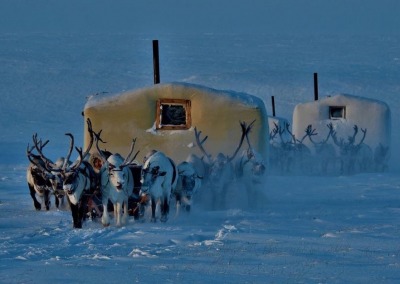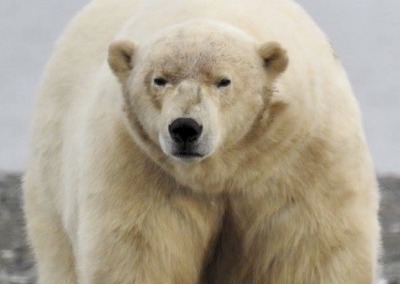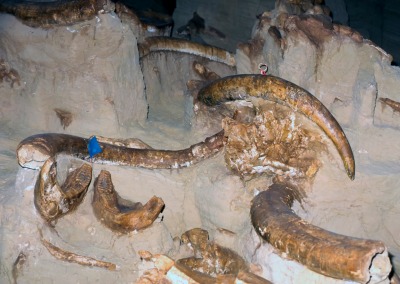Yakutia
Yakutia is the coldest inhabited part of the world. With a land area similar to India, it is also the biggest subject of the Russian Federation. It has a population of around 1 million, of whom 350,000 live in the capital, Yakutsk. This leaves the rest of Yakutia, a land the size of India, with only 650,000 inhabitants, As you can imagine, it has vast tracts of true untouched wilderness. It is also a land of extremes: in summer, temperatures can hit +40°C, whereas in winter, temperatures in the -70s have been officially registered, and unofficially in the -80s.
There are six indigenous groups inhabiting Yakutia. Five of them (Dolgans, Evenki, Evens, Yukhagir and Chukchi) are traditionally nomadic reindeer herders. The most numerous one, the Yakuts, are horse herders. The Dolgans have better preserved their traditional culture than the others. They live a fully nomadic lifestyle, migrating around once every ten days in winter and once every two days in summer. They live in wooden cabins built on sledge runners and insulated with reindeer furs. During migrations, they attach ten reindeer to each cabin to pull it to the new pasture area.
Many Yakutians are engaged in mammoth tusk hunting during the summer months. Hundreds of thousands of tons of mammoth tusks are suspected to
be frozen in the permafrost on which Yakutia sits. Every year the top few metres of permafrost melt. The expansion caused by this melting forces new tusks to the surface every year. For people willing to rough it and work hard for a few months over the summer, searching for these tusks can be a very profitable business.
On this website, we only offer tours to the Arctic part of Yakutia. We have a separate site, Travel Yakutia, which offers tours in the central and southern parts of the republic. Here, we offer tours to: join mammoth tusk hunters on their quest; migrate with the Dolgans 800 km north of the Arctic Circle; see walrus rookeries, polar bears, muskox and Arctic Ocean islands with colonies of over a million birds.
Although there are almost no permanent roads, in winter a network of zimniks (temporary winter tracks often built on frozen river surfaces) opens up otherwise inaccessible parts of the republic. This provides adventurous tourists with the opportunity for epic overland trips to the Arctic. We have organised overland trips from southern Yakutia to the Dolgans before, and from southern Yakutia to Chukotka. If you would be interested in such an expedition, please get in contact.
Yakutia is the coldest inhabited part of the world. With a land area similar to India, it is also the biggest subject of the Russian Federation. It has a population of around 1 million, of whom 350,000 live in the capital, Yakutsk. This leaves the rest of Yakutia, a land the size of India, with only 650,000 inhabitants, As you can imagine, it has vast tracts of true untouched wilderness. It is also a land of extremes: in summer, temperatures can hit +40°C, whereas in winter, temperatures in the -70s have been officially registered, and unofficially in the -80s.
There are six indigenous groups inhabiting Yakutia. Five of them (Dolgans, Evenki, Evens, Yukhagir and Chukchi) are traditionally nomadic reindeer herders. The most numerous one, the Yakuts, are horse herders. The Dolgans have better preserved their traditional culture than the others. They live a fully nomadic lifestyle, migrating around once every ten days in winter and once every two days in summer. They live in wooden cabins built on sledge runners and insulated with reindeer furs. During migrations, they attach ten reindeer to each cabin to pull it to the new pasture area.
Many Yakutians are engaged in mammoth tusk hunting during the summer months. Hundreds of thousands of tons of mammoth tusks are suspected to be frozen in the permafrost on which Yakutia sits. Every year the top few metres of permafrost melt. The expansion caused by this melting forces new tusks to the surface every year. For people willing to rough it and work hard for a few months over the summer, searching for these tusks can be a very profitable business.
On this website, we only offer tours to the Arctic part of Yakutia. We have a separate site, Travel Yakutia, which offers tours in the central and southern parts of the republic. Here, we offer tours to: join mammoth tusk hunters on their quest; migrate with the Dolgans 800 km north of the Arctic Circle; see walrus rookeries, polar bears, muskox and Arctic Ocean islands with colonies of over a million birds.
Although there are almost no permanent roads, in winter a network of zimniks (temporary winter tracks often built on frozen river surfaces) opens up otherwise inaccessible parts of the republic. This provides adventurous tourists with the opportunity for epic overland trips to the Arctic. We have organised overland trips from southern Yakutia to the Dolgans before, and from southern Yakutia to Chukotka. If you would be interested in such an expedition, please get in contact.



